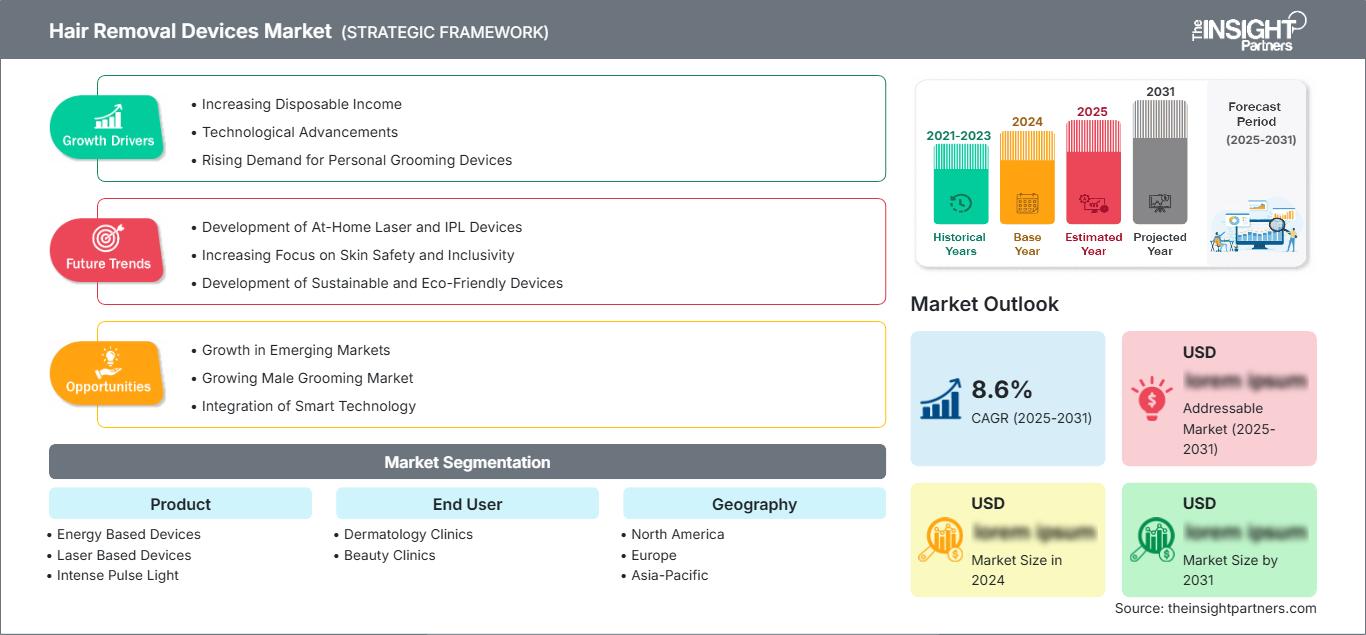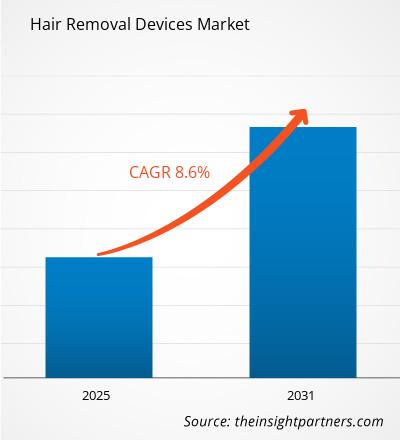Si prevede che il mercato dei dispositivi per la depilazione raggiungerà i 3,3 miliardi di dollari entro il 2031. Si prevede che il mercato registrerà un CAGR del 10,5% nel periodo 2025-2031.
Il rapporto è segmentato per prodotto (dispositivi a energia, dispositivi laser, luce pulsata intensa (IPL) e altri dispositivi). Il rapporto presenta inoltre un'analisi basata sull'utente finale (cliniche dermatologiche, centri estetici e altri). L'analisi globale è ulteriormente suddivisa a livello regionale e per i principali paesi. Il rapporto offre il valore in dollari per l'analisi e i segmenti sopra indicati.
Scopo del rapporto
Il rapporto Hair Removal Devices Market di The Insight Partners mira a descrivere il panorama attuale e la crescita futura, i principali fattori trainanti, le sfide e le opportunità. Ciò fornirà approfondimenti a vari stakeholder aziendali, come:
- Fornitori/produttori di tecnologia: per comprendere le dinamiche di mercato in evoluzione e conoscere le potenziali opportunità di crescita, consentendo loro di prendere decisioni strategiche informate.
- Investitori: per condurre un'analisi completa delle tendenze in merito al tasso di crescita del mercato, alle proiezioni finanziarie di mercato e alle opportunità esistenti lungo la catena del valore.
- Organismi di regolamentazione: per regolamentare le politiche e le attività di polizia nel mercato con l'obiettivo di ridurre al minimo gli abusi, preservare la fiducia degli investitori e sostenere l'integrità e la stabilità del mercato.
Segmentazione del mercato dei dispositivi per la depilazione Prodotto
- Dispositivi a energia
- Dispositivi laser
- Luce pulsata intensa
- Altri dispositivi
Utente finale
- Cliniche dermatologiche
- Cliniche estetiche
Potrai personalizzare gratuitamente qualsiasi rapporto, comprese parti di questo rapporto, o analisi a livello di paese, pacchetto dati Excel, oltre a usufruire di grandi offerte e sconti per start-up e università
Mercato dei dispositivi per la depilazione: Approfondimenti strategici

- Ottieni le principali tendenze chiave del mercato di questo rapporto.Questo campione GRATUITO includerà l'analisi dei dati, che vanno dalle tendenze di mercato alle stime e alle previsioni.
Fattori della crescita del mercato dei dispositivi per la depilazione
- Aumento del reddito disponibile: l'aumento del reddito disponibile globale ha portato a una maggiore spesa dei consumatori per prodotti estetici. Ciò ha portato allo sviluppo di trattamenti di depilazione avanzati, convenienti e accessibili per la popolazione comune. L'aumento del potere d'acquisto ha portato all'adozione di dispositivi avanzati per la depilazione, stimolando così la crescita del mercato.
- Progressi tecnologici: i progressi tecnologici nella tecnologia di depilazione, come i dispositivi laser portatili e la luce pulsata (IPL), rendono i trattamenti di depilazione più efficaci e accessibili per i consumatori. I dispositivi avanzati sono sicuri, facili da usare e offrono risultati duraturi con il minimo disagio. Inoltre, si prevede che lo sviluppo di laser a diodi, sistemi di raffreddamento e altri dispositivi guiderà la crescita del mercato.
- Crescente domanda di dispositivi per la cura personale: la crescente domanda di prodotti per la cura personale e la crescente importanza dell'aspetto fisico sono i fattori chiave che guidano il mercato dei dispositivi per la depilazione. La crescente consapevolezza tra la popolazione, diffusa attraverso piattaforme come i social media e l'industria della moda, gioca un ruolo significativo nella promozione dell'aspetto estetico. Di conseguenza, sia uomini che donne investono in soluzioni per la depilazione, stimolando la crescita del mercato dei dispositivi per uso domestico e dei trattamenti in clinica come laser e sistemi a luce pulsata intensa (IPL).
Tendenze future del mercato dei dispositivi per la depilazione
- Sviluppo di dispositivi laser e IPL per uso domestico: la crescente preferenza per i trattamenti domiciliari ha favorito la popolarità di dispositivi per la depilazione domestica come laser e sistemi IPL. I consumatori sono sempre più alla ricerca di alternative comode ed economiche per la casa, evitando così le visite al centro estetico.
- Crescente attenzione alla sicurezza della pelle e all'inclusività: la domanda di dispositivi per la depilazione sicuri ed efficaci per diverse tonalità di pelle e tipi di peli è in crescita. I recenti sviluppi si concentrano sullo sviluppo di tecnologie, come i laser a diodi e i laser Nd:YAG, che offrono trattamenti efficaci su tutti i tipi di pelle, soddisfacendo così un'ampia base di clienti.
- Sviluppo di dispositivi sostenibili ed ecocompatibili: a causa delle crescenti preoccupazioni ambientali, la domanda di prodotti per la depilazione sostenibili ed ecocompatibili è in crescita. Pertanto, i produttori utilizzano materiali riciclabili e realizzano dispositivi a basso consumo energetico che durano a lungo. La Pulse Light Clinic, con sede nel Regno Unito, utilizza macchinari a basso consumo energetico e gel rinfrescanti ecocompatibili, riducendo così il suo impatto ambientale complessivo.
Opportunità di mercato per i dispositivi per la depilazione
- Crescita nei mercati emergenti: le regioni emergenti dell'Asia-Pacifico, dell'America Latina e del Medio Oriente offrono opportunità significative per i produttori di dispositivi per la depilazione. Con l'urbanizzazione, l'aumento del reddito disponibile e la crescente consapevolezza delle procedure di cura personale, queste regioni creano opportunità redditizie per gli operatori del mercato internazionale.
- Crescita del mercato della cura maschile: la crescente popolarità delle procedure estetiche tra la popolazione maschile rappresenta un'opportunità crescente per i dispositivi per la depilazione. Lo sviluppo di un portafoglio prodotti specificamente rivolto agli uomini, come rasoi per il corpo, dispositivi laser per peli più folti e altri, probabilmente creerà opportunità di crescita per il mercato.
- Integrazione di tecnologie intelligenti: l'integrazione di tecnologie intelligenti e intelligenza artificiale nei dispositivi per la depilazione può offrire impostazioni di trattamento personalizzate, consentire il monitoraggio dei modelli di utilizzo e offrire risultati migliori. I dispositivi intelligenti offrono funzionalità come sensori per la tonalità della pelle, modalità di trattamento adattive e connettività tramite app per il monitoraggio dei progressi. Pertanto, l'integrazione di tecnologie intelligenti crea opportunità per gli operatori del mercato di soddisfare i consumatori alla ricerca di esperienze personalizzate.
Mercato dei dispositivi per la depilazione
Le tendenze regionali e i fattori che influenzano il mercato dei dispositivi per la depilazione durante il periodo di previsione sono stati ampiamente spiegati dagli analisti di The Insight Partners. Questa sezione illustra anche i segmenti e la geografia del mercato della gestione delle malattie del ritmo cardiaco in Nord America, Europa, Asia-Pacifico, Medio Oriente e Africa, America meridionale e centrale.
Ambito del rapporto di mercato sui dispositivi per la depilazione
| Attributo del rapporto | Dettagli |
|---|---|
| Dimensioni del mercato in 2024 | US$ XX Billion |
| Dimensioni del mercato per 2031 | US$ 3.3 Billion |
| CAGR globale (2025 - 2031) | 10.5% |
| Dati storici | 2021-2023 |
| Periodo di previsione | 2025-2031 |
| Segmenti coperti |
By Prodotto
|
| Regioni e paesi coperti | Nord America
|
| Leader di mercato e profili aziendali chiave |
|
Densità degli operatori del mercato dei dispositivi per la depilazione: comprendere il suo impatto sulle dinamiche aziendali
Il mercato dei dispositivi per la depilazione è in rapida crescita, trainato dalla crescente domanda da parte degli utenti finali, dovuta a fattori quali l'evoluzione delle preferenze dei consumatori, i progressi tecnologici e una maggiore consapevolezza dei benefici del prodotto. Con l'aumento della domanda, le aziende stanno ampliando la propria offerta, innovando per soddisfare le esigenze dei consumatori e sfruttando le tendenze emergenti, alimentando ulteriormente la crescita del mercato.

- Ottieni il Mercato dei dispositivi per la depilazione Panoramica dei principali attori chiave
Punti di forza
- Copertura completa: il rapporto analizza in modo esaustivo prodotti, servizi, tipologie e utenti finali del mercato dei dispositivi per la depilazione, offrendo una panoramica olistica.
- Analisi degli esperti: il rapporto è redatto sulla base della conoscenza approfondita di esperti e analisti del settore.
- Informazioni aggiornate: il rapporto garantisce rilevanza aziendale grazie alla copertura di informazioni e tendenze dei dati recenti.
- Opzioni di personalizzazione: questo rapporto può essere personalizzato per soddisfare le esigenze specifiche del cliente e adattarsi in modo appropriato alle strategie aziendali.
Il rapporto di ricerca sul mercato dei dispositivi per la depilazione può quindi aiutare a guidare il percorso di decodificazione e comprensione dello scenario del settore e delle prospettive di crescita. Sebbene possano esserci alcune preoccupazioni valide, i vantaggi complessivi di questo rapporto tendono a superare gli svantaggi.
- Analisi storica (2 anni), anno base, previsione (7 anni) con CAGR
- Analisi PEST e SWOT
- Valore/volume delle dimensioni del mercato - Globale, Regionale, Nazionale
- Industria e panorama competitivo
- Set di dati Excel
Report recenti
Rapporti correlati
Testimonianze
Motivo dell'acquisto
- Processo decisionale informato
- Comprensione delle dinamiche di mercato
- Analisi competitiva
- Analisi dei clienti
- Previsioni di mercato
- Mitigazione del rischio
- Pianificazione strategica
- Giustificazione degli investimenti
- Identificazione dei mercati emergenti
- Miglioramento delle strategie di marketing
- Aumento dell'efficienza operativa
- Allineamento alle tendenze normative




















 Ottieni un campione gratuito per - Mercato dei dispositivi per la depilazione
Ottieni un campione gratuito per - Mercato dei dispositivi per la depilazione